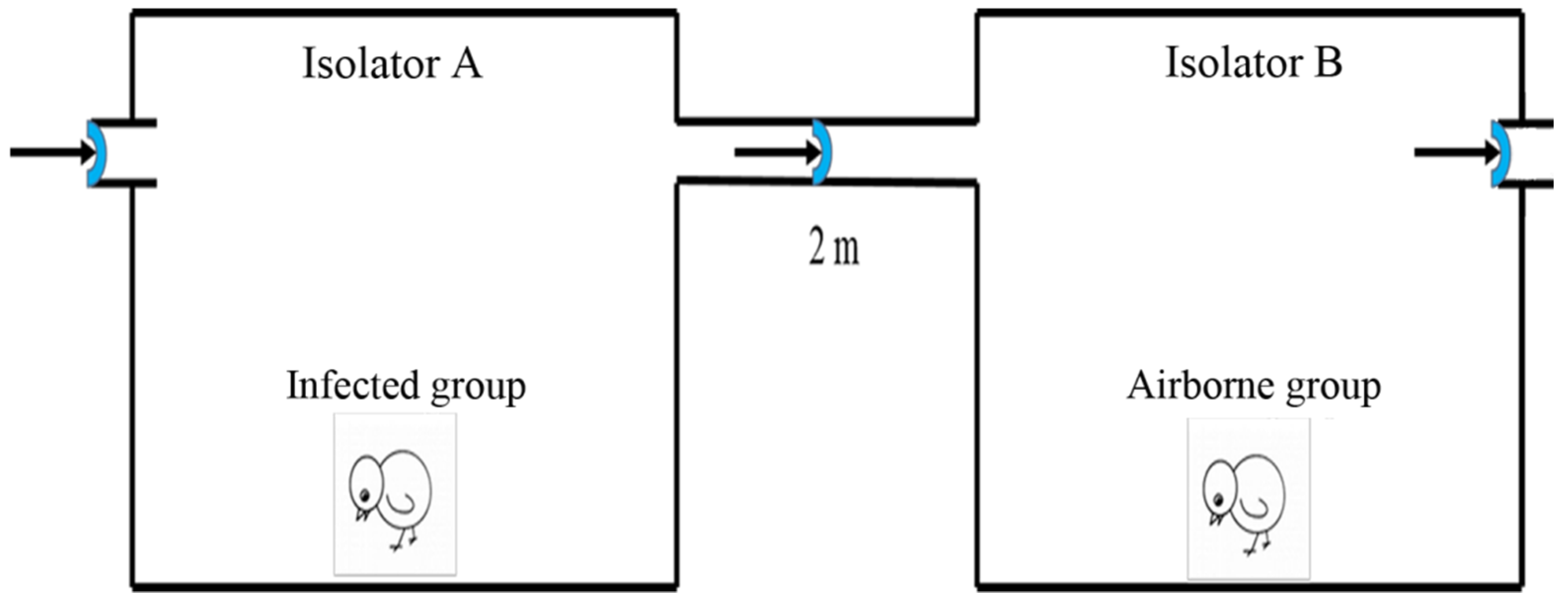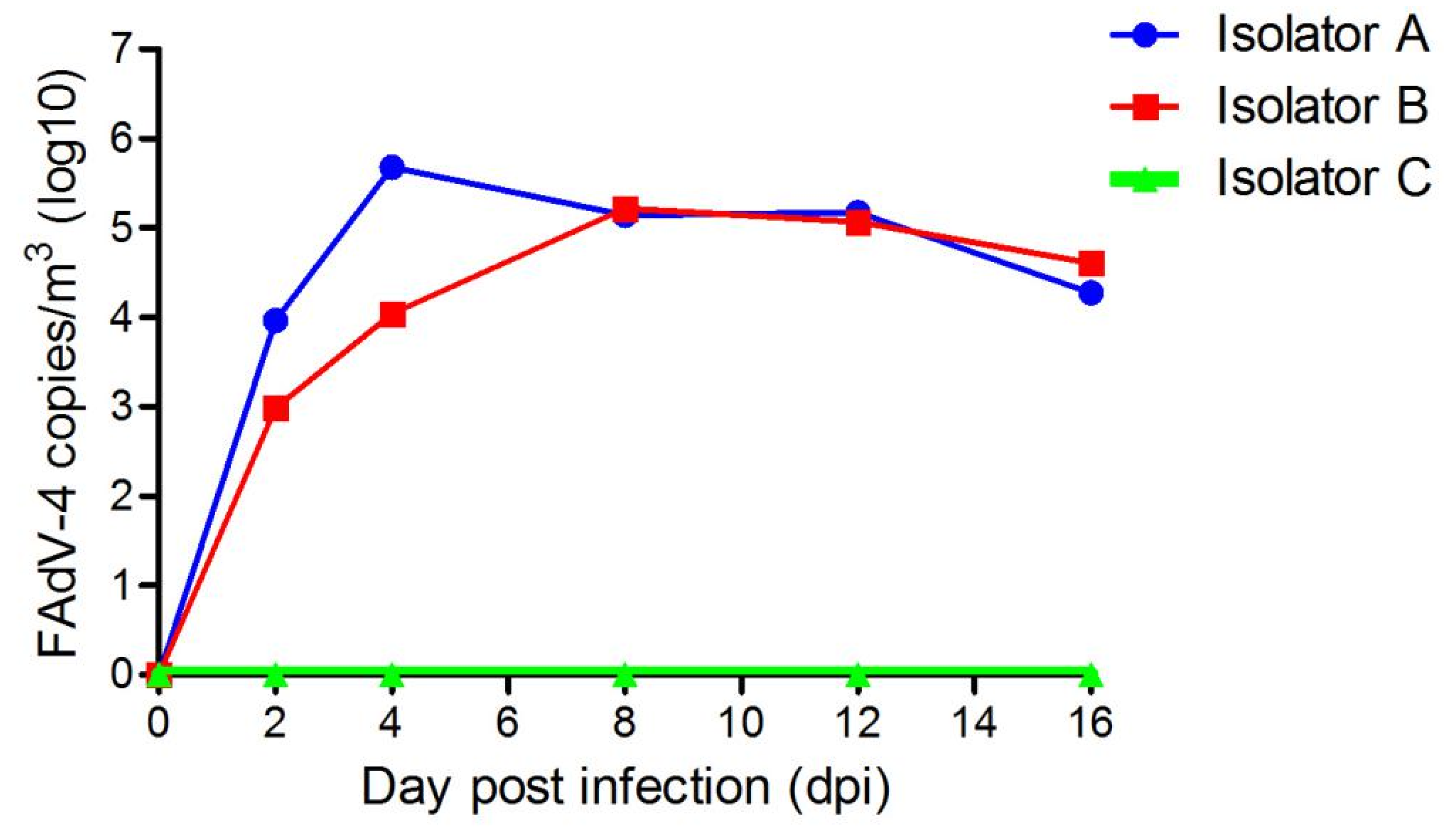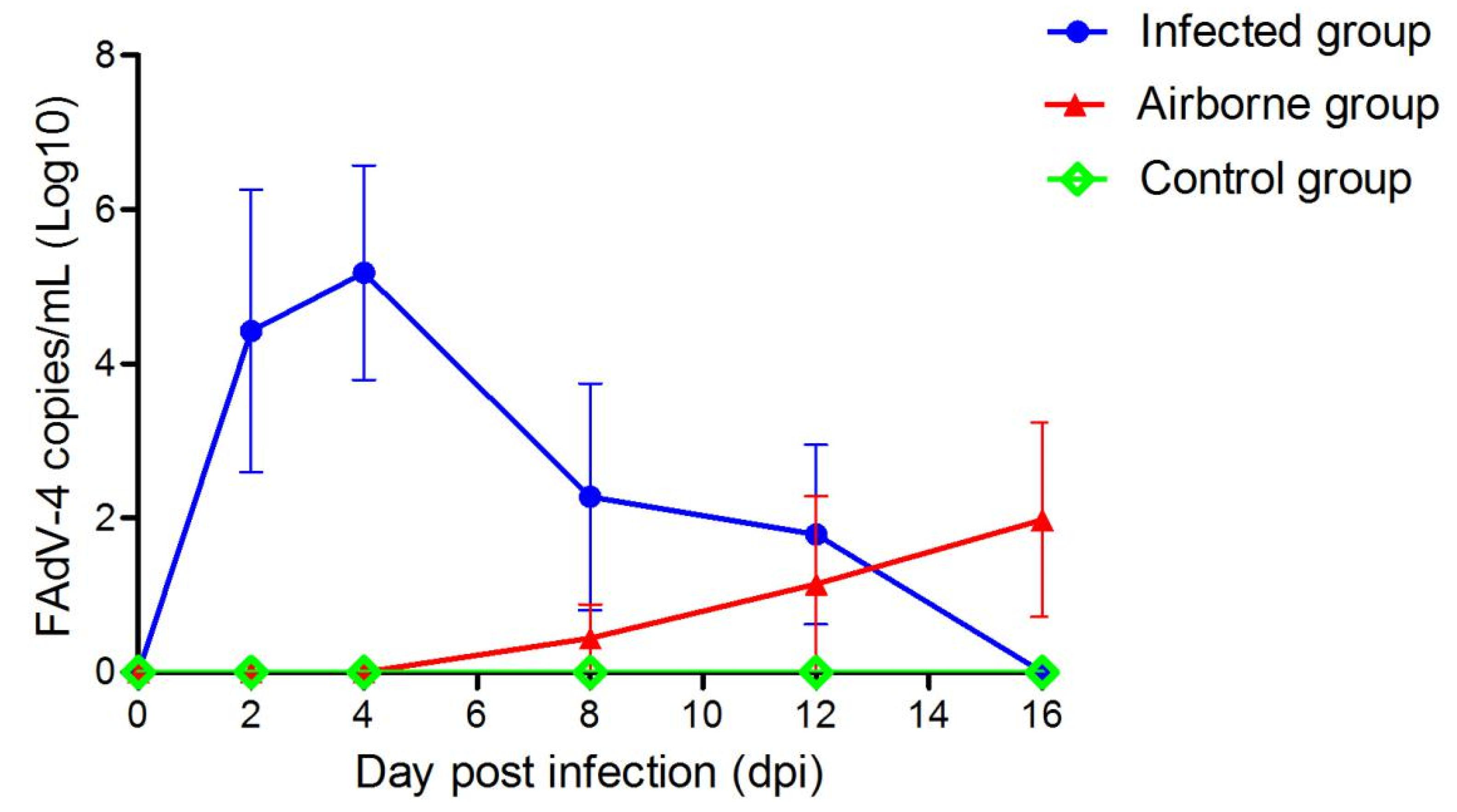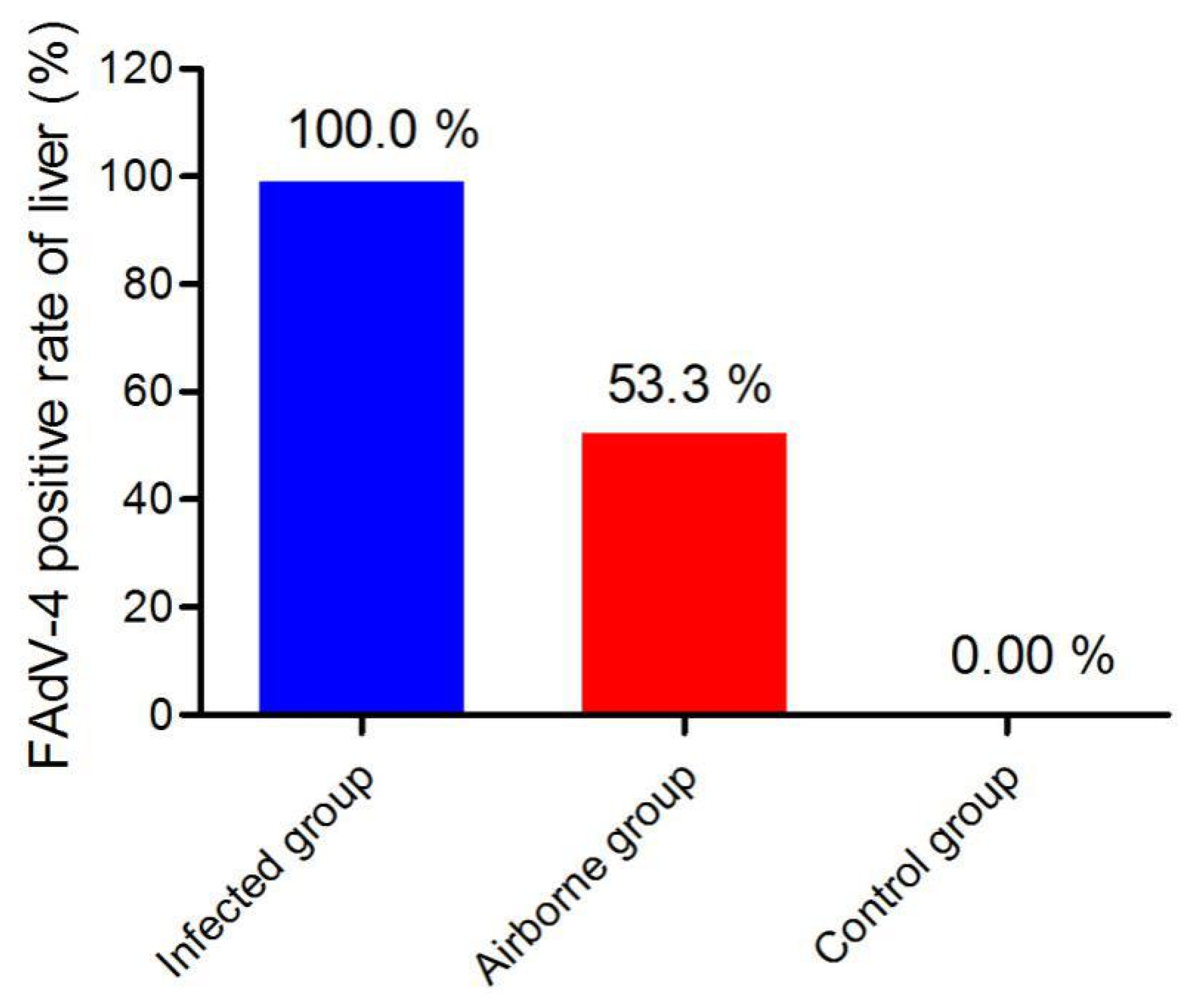Airborne Transmission of a Serotype 4 Fowl Adenovirus in Chickens
Abstract
1. Introduction
2. Materials and Methods
2.1. Ethics Statement
2.2. Experimental Design
2.3. FAdV-4 Preparation and Inoculation
2.4. Clinical Observation and Post-Mortem Examination
2.5. Collection of Air Sample
2.6. Collection of Serum, Liver, Oral, and Cloaca Samples
2.7. Hexon Gene Sequence Alignment
3. Results
3.1. Clinical Observations and Necropsy/Post-Mortem Findings
3.2. Detection of FAdV-4 Aerosol
3.3. Viremia and FAdV-4 Antibody
3.4. Virus Shedding
3.5. Viral DNA Detection in the Liver
3.6. Sequence Alignment of Hexon Gene
4. Discussion
5. Conclusions
Author Contributions
Acknowledgments
Conflicts of Interest
References
- Griffin, B.D.; Nagy, E. Coding potential and transcript analysis of fowl adenovirus 4: Insight into upstream ORFs as common sequence features in adenoviral transcripts. J. Gen. Virol. 2011, 92, 1260–1272. [Google Scholar] [CrossRef] [PubMed]
- Xie, Z.; Luo, S.; Fan, Q.; Xie, L.; Liu, J.; Xie, Z. Detection of antibodies specific to the nonstructural proteins of fowl adenoviruses in infected chickens but not in vaccinated chickens. Avian Pathol. 2013, 42, 491–496. [Google Scholar] [CrossRef] [PubMed]
- Li, P.H.; Zheng, P.P.; Zhang, T.F.; Wen, G.Y.; Shao, H.B.; Luo, Q.P. Fowl adenovirus serotype 4: Epidemiology, pathogenesis, diagnostic detection, and vaccine strategies. Poult. Sci. 2017, 96, 2630–2640. [Google Scholar] [CrossRef] [PubMed]
- Pan, Q.; Liu, L.L.; Wang, Y.Q.; Zhang, Y.P.; Qi, X.L.; Liu, C.J.; Gao, Y.L.; Wang, X.M.; Cui, H.Y. The first whole genome sequence and pathogenicity characterization of a fowl adenovirus 4 isolated from ducks associated with inclusion body hepatitis and hydropericardium syndrome. Avian Pathol. 2017, 46, 571–578. [Google Scholar] [CrossRef] [PubMed]
- Schachner, A.; Marek, A.; Jaskulska, B.; Bilic, I.; Hess, M. Recombinant FAdV-4 fiber-2 protein protects chickens against hepatitis-hydropericardium syndrome (HHS). Vaccine 2014, 32, 1086–1092. [Google Scholar] [CrossRef] [PubMed]
- Dahiya, S.; Srivastava, R.N.; Hess, M.; Gulati, B.R. Fowl adenovirus serotype 4 associated with outbreaks of infectious hydropericardium in Haryana, India. Avian Dis. 2002, 46, 230–233. [Google Scholar] [CrossRef]
- Zhang, T.; Jin, Q.Y.; Ding, P.Y.; Wang, Y.B.; Chai, Y.X.; Li, Y.F.; Liu, X.; Luo, J.; Zhang, G.P. Molecular epidemiology of hydropericardium syndrome outbreakassociated serotype 4 fowl adenovirus isolates in central China. Virol. J. 2016, 13, 188. [Google Scholar] [CrossRef] [PubMed]
- Niu, Y.J.; Sun, W.; Zhang, G.H.; Qu, Y.J.; Wang, P.F.; Sun, H.L.; Xiao, Y.H.; Liu, S.D. Hydropericardium syndrome outbreak caused by fowl adenovirus serotype 4 in China in 2015. J. Gen. Virol. 2016, 97, 2684. [Google Scholar]
- Naeem, K.; Akram, H. Hydropericardium syndrome outbreak in a pigeon flock. Vet. Rec. 1995, 136, 296–297. [Google Scholar] [CrossRef]
- Kumar, R.; Kumar, V.; Asthana, M.; Shukla, S.K.; Chandra, R. Isolation and Identification of a Fowl Adenovirus from Wild Black Kites (Milvus migrans). J. Wildl. Dis. 2010, 46, 272. [Google Scholar] [CrossRef]
- Grgić, H.; Poljak, Z.; Sharif, S.; Nagy, É. Pathogenicity and cytokine gene expression pattern of a serotype 4 fowl adenovirus isolate. PLoS ONE 2013, 8, e77601. [Google Scholar] [CrossRef]
- Li, H.; Wang, J.; Qiu, L.; Han, Z.; Liu, S. Fowl adenovirus species C serotype 4 is attributed to the emergence of hepatitis-hydropericardium syndrome in chickens in China. Infect. Genet. Evol. 2016, 45, 230–241. [Google Scholar] [CrossRef]
- Liu, Y.; Wan, W.; Gao, D.; Li, Y.; Yang, X.; Liu, H.; Yao, H.; Chen, L.; Wang, C.; Zhao, J. Genetic characterization of novel fowl aviadenovirus 4 isolates from outbreaks of hepatitis-hydropericardium syndrome in broiler chickens in China. Emerg. Microbes Infect. 2016, 5, e117. [Google Scholar] [CrossRef]
- Niu, Y.; Sun, Q.; Zhang, G.; Sun, W.; Liu, X.; Xiao, Y.; Shang, Y.; Liu, S. Epidemiological investigation of outbreaks of fowl adenovirus infections in commercial chickens in China. Transbound. Emerg. Dis. 2017, 65, e121–e126. [Google Scholar] [CrossRef]
- Guan, R.; Tian, Y.; Han, X.; Yang, X.; Wang, H. Complete genome sequence and pathogenicity of fowl adenovirus serotype 4 involved in hydropericardium syndrome in Southwest China. Microb. Pathog. 2018, 117, 290–298. [Google Scholar] [CrossRef]
- Li, Y.; Fu, J.; Chang, S.; Fang, L.; Cui, S.; Wang, Y.; Cui, Z.; Zhao, P. Isolation, identification, and hexon gene characterization of fowl adenoviruses from a contaminated live Newcastle disease virus vaccine. Poult. Sci. 2016, 96, 1094. [Google Scholar] [CrossRef]
- Grgíc, H.; Philippe, C.; Ojkíc, D.; Nagy, É. Study of vertical transmission of fowl adenoviruses. Can. J. Vet. Res. 2006, 70, 230. [Google Scholar]
- Balamurugan, V.; Kataria, J.M. The Hydropericardium Syndrome in Poultry—A Current Scenario. Vet. Res. Commun. 2004, 28, 127–148. [Google Scholar] [CrossRef]
- Li, X.; Chai, T.; Wang, Z.; Song, C.; Cao, H.; Liu, J.; Zhang, X.; Wang, W.; Yao, M.; Miao, Z. Occurrence and transmission of Newcastle disease virus aerosol originating from infected chickens under experimental conditions. Vet. Microbiol. 2009, 136, 226–232. [Google Scholar] [CrossRef]
- Lv, J.; Wei, B.; Yang, Y.; Yao, M.; Cai, Y.; Gao, Y.; Xia, X.; Zhao, X.; Liu, Z.; Li, X. Experimental transmission in guinea pigs of H9N2 avian influenza viruses from indoor air of chicken houses. Virus Res. 2012, 170, 102–108. [Google Scholar] [CrossRef]
- Cumming, R.B. Studies on Australian infectious bronchitis virus. IV. Apparent farm-to-farm airborne transmission of infectious bronchitis virus. Avian Dis. 1970, 14, 191–195. [Google Scholar] [CrossRef]
- Xuesong, L.; Ying, S.; Qinfang, L.; Ying, W.; Guoxin, L.; Qiaoyang, T.; Yuee, Z.; Sidang, L.; Zejun, L. Airborne Transmission of a Novel Tembusu Virus in Ducks. J. Clin. Microbiol. 2015, 53, 2734–2736. [Google Scholar]
- Mars, M.H.; de Jong, M.C.M.; Van Maanen, C.; Hage, J.J.; Van Oirschot, J.T. Airborne transmission of bovine herpesvirus 1 infections in calves under field conditions. Vet. Microbiol. 2000, 76, 1–13. [Google Scholar] [CrossRef]
- Brockmeier, S.L.; Lager, K.M. Experimental airborne transmission of porcine reproductive and respiratory syndrome virus and Bordetella bronchiseptica. Vet. Microbiol. 2002, 89, 267–275. [Google Scholar] [CrossRef]
- Kristensen, C.S.; Bøtner, A.; Takai, H.; Nielsen, J.P.; Jorsal, S.E. Experimental airborne transmission of PRRS virus. Vet. Microbiol. 2004, 99, 197–202. [Google Scholar] [CrossRef]
- Amaral-Doel, C.M.; Gloster, J.; Valarcher, J.F. Airborne transmission of foot-and-mouth disease in pigs: Evaluation and optimisation of instrumentation and techniques. Vet. J. 2009, 179, 219–224. [Google Scholar] [CrossRef]
- Dubose, R.T. Quail Bronchitis1. J. Wildl. Dis. 1967, 3, 10–13. [Google Scholar]
- Hao, H.; Chao, L.; Qiu, Y.; Wang, F.; Ai, W.; Jing, G.; Wei, L.; Li, X.; Sun, L.; Jie, W. Generation, transmission and infectiosity of chicken MDV aerosols under experimental conditions. Vet. Microbiol. 2014, 172, 400–406. [Google Scholar] [CrossRef]
- Lowen, A.C.; Steel, J.; Mubareka, S.; Palese, P. High temperature (30 °C) blocks aerosol but not contact transmission of influenza virus. J. Virol. 2008, 82, 5650–5652. [Google Scholar] [CrossRef]
- Yu, G.; Wang, Y.; Zhang, M.; Lin, Y.; Tang, Y.; Diao, Y. Pathogenic, Phylogenetic, and Serological Analysis of Group I Fowl Adenovirus Serotype 4 SDSX Isolated From Shandong, China. Front. Microbiol. 2018, 9, 2772. [Google Scholar] [CrossRef]
- Niczyporuk, J.S. Phylogenetic and geographic analysis of fowl adenovirus field strains isolatedfrom poultry in Poland. Arch. Virol. 2016, 161, 33–42. [Google Scholar] [CrossRef]
- Hugh-Jones, M.; Allan, W.H.; Dark, F.A.; Harper, G.J. The evidence for the airborne spread of Newcastle disease. J. Hyg. 1973, 71, 325–339. [Google Scholar] [CrossRef]
- Alexander, D.J. The epidemiology and control of avian influenza and Newcastle disease. J. Comp. Pathol. 1995, 112, 105. [Google Scholar] [CrossRef]
- Jones, A.M.; Harrison, R.M. The effects of meteorological factors on atmospheric bioaerosol concentrations—A review. Sci. Total Environ. 2004, 326, 151–180. [Google Scholar] [CrossRef]
- Tseng, C.C.; Li, C.S. Collection efficiencies of aerosol samplers for virus-containing aerosols. J. Aerosol Sci. 2005, 36, 593–607. [Google Scholar] [CrossRef]
- Chen, F.Y. Veterinary Lemology, 6th ed.; China Agriculture Press: Beijing, China, 2016; pp. 12–13. [Google Scholar]







| Primer Name | Sequence(5′-3′) | Product Size (bp) | GenBank No. |
|---|---|---|---|
| FAdV (qPCR) | F: 5′-GACGGCGGCGCAGGTGACGAAGATT-3′ | 126 | U46933 |
| R: 5′-TGAGACTTGGCGAAGCGACCGAGCA-3′ | |||
| FAdV (PCR) | F: 5′-AATTTCGACCCCATGACGCGCCAGG-3′ | 508 | |
| R: 5′-TGGCGA AAGGCGTACGGAAGTAAGC-3′ | |||
| FAdV (Hexon) | F1: 5′-TGGACATGGGGGCGACCTA-3′ | 1219 | |
| R1: 5′-AAGGGATTGACGTTGTCCA-3′ | |||
| F1: 5′-AACGTCAATCCCTTCAACCACC-3′ | 1350 | ||
| R1: 5′-TTGCCTGTGGCGAAAGGCG-3′ |
© 2019 by the authors. Licensee MDPI, Basel, Switzerland. This article is an open access article distributed under the terms and conditions of the Creative Commons Attribution (CC BY) license (http://creativecommons.org/licenses/by/4.0/).
Share and Cite
Li, G.; Yu, G.; Niu, Y.; Cai, Y.; Liu, S. Airborne Transmission of a Serotype 4 Fowl Adenovirus in Chickens. Viruses 2019, 11, 262. https://doi.org/10.3390/v11030262
Li G, Yu G, Niu Y, Cai Y, Liu S. Airborne Transmission of a Serotype 4 Fowl Adenovirus in Chickens. Viruses. 2019; 11(3):262. https://doi.org/10.3390/v11030262
Chicago/Turabian StyleLi, Gang, Guanliu Yu, Yujuan Niu, Yumei Cai, and Sidang Liu. 2019. "Airborne Transmission of a Serotype 4 Fowl Adenovirus in Chickens" Viruses 11, no. 3: 262. https://doi.org/10.3390/v11030262
APA StyleLi, G., Yu, G., Niu, Y., Cai, Y., & Liu, S. (2019). Airborne Transmission of a Serotype 4 Fowl Adenovirus in Chickens. Viruses, 11(3), 262. https://doi.org/10.3390/v11030262





